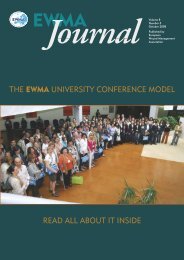best practice for the management of lymphoedema ... - EWMA
best practice for the management of lymphoedema ... - EWMA
best practice for the management of lymphoedema ... - EWMA
You also want an ePaper? Increase the reach of your titles
YUMPU automatically turns print PDFs into web optimized ePapers that Google loves.
ASSESSMENT<br />
TESTING FOR<br />
PITTING<br />
Pitting indicates <strong>the</strong><br />
presence <strong>of</strong> excess<br />
interstitial fluid, ie tissue<br />
oedema. Pitting is usually<br />
tested <strong>for</strong> by pressing<br />
firmly, but without hurting<br />
<strong>the</strong> patient, on <strong>the</strong> area to<br />
be examined with a finger<br />
or thumb <strong>for</strong> a count <strong>of</strong> at<br />
least 10 seconds. If an<br />
indentation remains when<br />
<strong>the</strong> examiner ceases<br />
pressing, pitting is present.<br />
The depth <strong>of</strong> <strong>the</strong><br />
indentation reflects <strong>the</strong><br />
severity <strong>of</strong> <strong>the</strong> oedema.<br />
In a research setting, <strong>the</strong><br />
pitting test may be defined<br />
in terms <strong>of</strong> <strong>the</strong> pressure<br />
applied and <strong>the</strong> length <strong>of</strong><br />
application, and<br />
measurement <strong>of</strong> <strong>the</strong> depth<br />
<strong>of</strong> any resulting<br />
indentation.<br />
Lymphadenopathy: enlargement <strong>of</strong><br />
<strong>the</strong> lymph nodes<br />
Hyperkeratosis: thickening <strong>of</strong> <strong>the</strong><br />
outer layer <strong>of</strong> <strong>the</strong> skin<br />
Elephantiasis: severe<br />
<strong>lymphoedema</strong> characterised by<br />
severe swelling, hard thickened<br />
tissue, deep skin folds and skin<br />
changes such as hyperkeratosis and<br />
warty growths<br />
Assessment <strong>of</strong> swelling<br />
The duration, location and extent <strong>of</strong> <strong>the</strong><br />
swelling and any pitting should be recorded,<br />
along with <strong>the</strong> location <strong>of</strong> any<br />
lymphadenopathy, <strong>the</strong> quality <strong>of</strong> <strong>the</strong> skin<br />
and subcutaneous tissue, and <strong>the</strong> degree <strong>of</strong><br />
shape distortion. Limb circumference and<br />
volume should be measured.<br />
Limb volume measurement<br />
Limb volume measurement is one <strong>of</strong> <strong>the</strong><br />
methods used to determine <strong>the</strong> severity <strong>of</strong><br />
<strong>the</strong> <strong>lymphoedema</strong>, <strong>the</strong> appropriate<br />
<strong>management</strong>, and <strong>the</strong> effectiveness <strong>of</strong><br />
treatment. Typically, limb volume is<br />
measured on diagnosis, after two weeks <strong>of</strong><br />
intensive <strong>the</strong>rapy with multi-layer<br />
inelastic <strong>lymphoedema</strong> bandaging<br />
(MLLB), and at follow-up assessment.<br />
In unilateral limb swelling, both <strong>the</strong><br />
affected and unaffected limbs are<br />
measured. The difference in limb volume<br />
is expressed in millilitres (ml) or as a<br />
percentage.<br />
Oedema is considered present if <strong>the</strong><br />
volume <strong>of</strong> <strong>the</strong> swollen limb is more than<br />
10% greater than that <strong>of</strong> <strong>the</strong> contralateral<br />
unaffected limb. The dominant limb<br />
should be noted: in unaffected patients,<br />
<strong>the</strong> dominant limb can have a<br />
circumference up to 2cm greater and a<br />
volume as much as 8-9% higher than <strong>the</strong><br />
nondominant limb 32,33 .<br />
In bilateral limb oedema, <strong>the</strong> volume <strong>of</strong><br />
both limbs is measured and used to track<br />
treatment progress.<br />
There is no effective method <strong>for</strong><br />
measuring oedema affecting <strong>the</strong> head<br />
and neck, breast, trunk or genitalia.<br />
Digital photography is recommended as<br />
an appropriate means to subjectively<br />
record and monitor facial and genital<br />
<strong>lymphoedema</strong> 34 .<br />
Water displacement method<br />
The water displacement method (also<br />
known as water plethysmography) is<br />
considered <strong>the</strong> 'gold standard' <strong>for</strong> calculating<br />
limb volume and is <strong>the</strong> only reliable<br />
method available <strong>for</strong> <strong>the</strong> measurement <strong>of</strong><br />
oedematous hands and feet 35 . It uses <strong>the</strong><br />
principle that an object will displace its<br />
own volume <strong>of</strong> water. However,<br />
ASSESSMENT<br />
practicalities, such as hygiene issues and<br />
accessing this method, limit its use.<br />
Circumferential limb measurements<br />
Calculation <strong>of</strong> volume from circumferential<br />
measurements is <strong>the</strong> most widely used<br />
method. It is easily accessible and its<br />
reliability can be improved if a standard<br />
protocol is followed.<br />
Circumferential measurements <strong>of</strong> limbs<br />
(Figure 3) are put into a specialist computer<br />
program or calculator <strong>for</strong> determination <strong>of</strong><br />
individual limb volume and excess limb<br />
volume. Some practitioners have set up<br />
standard spreadsheet programs to calculate<br />
volume.<br />
A simplified method <strong>for</strong> <strong>the</strong> measurement<br />
<strong>of</strong> patients with palliative care needs is shown<br />
in Figure 4 (page 12). These measurements<br />
are not used to calculate limb volume, but to<br />
track sequential changes in circumference.<br />
Perometry<br />
Perometry uses infrared light beams to<br />
measure <strong>the</strong> outline <strong>of</strong> <strong>the</strong> limb. From <strong>the</strong>se<br />
measurements, limb volume (but not hand or<br />
foot volume) can be calculated quickly,<br />
accurately and reproducibly 36 . Although <strong>the</strong><br />
use <strong>of</strong> perometry is becoming more<br />
widespread, <strong>the</strong> cost <strong>of</strong> <strong>the</strong> machine limits it<br />
to specialist centres.<br />
Bioimpedance<br />
Bioimpedance measures tissue resistance to<br />
an electrical current to determine<br />
extracellular fluid volume. The technique is<br />
not yet established in routine <strong>practice</strong>.<br />
However, it may prove useful in<br />
demonstrating early <strong>lymphoedema</strong>,<br />
identifying lipoedema, and in monitoring <strong>the</strong><br />
outcome <strong>of</strong> treatment 31 . The technique is<br />
currently <strong>of</strong> limited use in bilateral swelling.<br />
Limitations <strong>of</strong> excess limb volume<br />
Calculation <strong>of</strong> excess limb volume is <strong>of</strong><br />
limited use in bilateral <strong>lymphoedema</strong>. In<br />
such cases measurements can be used to<br />
track sequential changes in limb<br />
circumference to indicate treatment<br />
progress. In patients with extensive<br />
hyperkeratosis, elephantiasis or tissue<br />
thickening it should be recognised that a<br />
proportion <strong>of</strong> <strong>the</strong> excess volume will be due<br />
to factors o<strong>the</strong>r than fluid accumulation.<br />
10 BEST PRACTICE FOR THE MANAGEMENT OF LYMPHOEDEMA

















